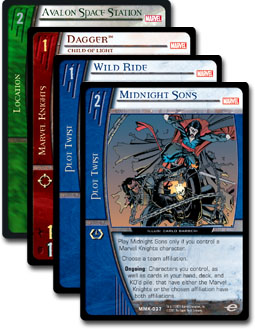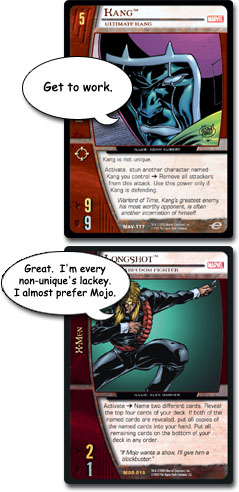
By now, you’ve come to expect four primary teams in each Vs. System expansion. The Web of Spider-Man set was a notable exception in which we chose to focus on just two teams. Marvel Origins formerly had the honor of housing our largest secondary team, Sentinels, which had nineteen cards compared to the roughly 30–40 for the primary teams. Then there was the Fearsome Five with seven members and a lone plot twist. Besides them, teams beyond the primary four in each set remained quite small. For example, Skrulls and Negative Zone have only a few cards and are still waiting for some companions.
When Avengers was in the works, we wanted Kang in the set for thematic reasons. We decided that it would be included in a way that approximated how the Sentinels were handled in Marvel Origins. We had the luxury of attempting a fifth team thanks in great part to our larger 220-card set sizes (as opposed to the 165-card sets used from DC Origins to Man of Steel). In the end, we made room for 23 Kang-specific cards in the set.
From the outset, we planned to have all of the Kang characters be non-unique. However, the thematics of the team were almost completely redesigned and the cards were almost entirely rewritten. You may recall from Brian Kibler’s preview article that Kang was initially envisioned as a team with many activated powers and readying effects. After all, we figured we could tackle one of the most difficult effects to balance in Vs. System, character-readying effects, by having the readying cards only affect characters named Kang. As it turned out, it was still challenging to reach a balance with these effects where they would be useful in Sealed Pack and not too powerful in Booster Draft.
Since nobody was particularly happy with how Kang was playing out at that time, R&D broke down into work groups to redesign the team. As I recall, Andrew Yip and Ben Seck worked as a pair and Justin Gary and Brian Kibler formed a separate duo. Each group reworked all of the Kang cards and submitted those ideas to Mike Hummel, who then re-forged the team. The Kang Council then started to take on a feel of Kang “coming and going,” exemplifying his time-travel via various versions popping into or out of the visible area, either by moving to the hidden area or by being removed from the game.
Kang in Constructed
From what we’d learned from non-uniqueness in other decks, such as Spider-Man, Superman, and Army decks in general, we knew we’d have our hands full balancing Kang. Kang had a huge advantage over the Superman and Spider-Man variants in that he was naturally not unique. And we’d seen the advantages afforded by non-uniqueness when it came to being able to play a character at a time when you might otherwise miss a drop because of uniqueness and powering up. This is one of the subtle strengths in decks like Curve Sentinels. Besides the inherent strengths of having eleven non-unique characters with the same name, we also knew we had to pay particular attention to decks with Lost City and Longshot.
Most of our playtesting with Lost City involved a straightforward team-up between Kang Council and Brotherhood. These decks were certainly powerful once they got rolling, and Kang, Kang Kong added to consistency when compared to traditional Lost City builds. The late game of this deck was exceptionally powerful, with Kang, Immortus entering into the equation. The early game of such decks, and the Kang Council in general, wasn’t particularly well equipped to slow down the most aggressive decks. We were content to leave this as a slight weakness that could be overcome by the team’s strong late game or by teaming up with other teams. While our Kang/Lost City decks were very powerful once all of the components came together, their key cards were still susceptible to any number of cards (such as Have a Blast!) disrupting the resource row. And while Kang, Kang Kong helped to get the missing pieces, teaming up still added constraints not present in a straightforward Big Brotherhood build.
 At $10K Madrid in late March, Jose Maria Aramburu showed the Vs. community a thing or two about bringing two teams together. Among other things, he was coupling the power of Lost City with the power-up engine of Centurious. But rather than simply teaming up those two teams, he used Marvel Knights as the bridge between them. While this may seem like a very roundabout way of doing that, it is surprisingly efficient. The team-up can easily be accomplished with Dagger, Child of Light (ideally along with some other low cost Marvel Knights characters), Midnight Sons, Wild Ride, and Avalon Space Station. The Station not only powers the Lost City late in the game, but can also recur Dagger, Child of Light early on to get the necessary duplicate copies of Midnight Sons. It wasn’t clear until this event just how much potential there was in this technique. In fact, this event took place after we had already finished the Avengers set.
At $10K Madrid in late March, Jose Maria Aramburu showed the Vs. community a thing or two about bringing two teams together. Among other things, he was coupling the power of Lost City with the power-up engine of Centurious. But rather than simply teaming up those two teams, he used Marvel Knights as the bridge between them. While this may seem like a very roundabout way of doing that, it is surprisingly efficient. The team-up can easily be accomplished with Dagger, Child of Light (ideally along with some other low cost Marvel Knights characters), Midnight Sons, Wild Ride, and Avalon Space Station. The Station not only powers the Lost City late in the game, but can also recur Dagger, Child of Light early on to get the necessary duplicate copies of Midnight Sons. It wasn’t clear until this event just how much potential there was in this technique. In fact, this event took place after we had already finished the Avengers set.
The most recent Golden Age $10K in Atlanta showed the emergence of Kang/Lost City decks. There were apparently four such decks in a field of 99 players. From the Metagame.com coverage, one can see that the deck finished eighth, ninth, and fourteenth in the hands of Jason Tassitano, Joseph Carey, and Patrick Yapjoco respectively. Not bad for a deck’s first appearance in a premiere event, especially given that the versions could likely have been improved upon by comparison with one another. At least for the moment, it’s up in the air whether cards like Daredevil, Protector of Hell’s Kitchen belong in the deck. The answer to this may depend on whether or not cards like Search and Destroy become more popular and make 3-cost Kangs a risky proposition.
 We were also wary of creating a deck that could too easily exploit Longshot. There is quite a bit of overlap here with the discussion of Lost City decks. Longshot has only prospered thus far when he’s had an easy call on two cards, but not on just one. For example, he made a strong impression when he was calling out Wild Sentinels and Sentinel Mark IV. Sure, he can make use of cards like Night Vision or Base of Operations, but such cards tend to dilute the power level of decks and these types of decks face inconsistencies in getting both Longshot and his support cards. Until very late in development, Kang, Master of Time interacted too favorably with Longshot. He read, “At the start of the combat phase, put a card from your hand on the top of your deck. At the start of the recovery phase, draw two cards.” While we liked how this card interacted with shuffling and reveal effects like Game of the Galaxy, we decided it was for the best if it didn’t work so well with the mullet man.
We were also wary of creating a deck that could too easily exploit Longshot. There is quite a bit of overlap here with the discussion of Lost City decks. Longshot has only prospered thus far when he’s had an easy call on two cards, but not on just one. For example, he made a strong impression when he was calling out Wild Sentinels and Sentinel Mark IV. Sure, he can make use of cards like Night Vision or Base of Operations, but such cards tend to dilute the power level of decks and these types of decks face inconsistencies in getting both Longshot and his support cards. Until very late in development, Kang, Master of Time interacted too favorably with Longshot. He read, “At the start of the combat phase, put a card from your hand on the top of your deck. At the start of the recovery phase, draw two cards.” While we liked how this card interacted with shuffling and reveal effects like Game of the Galaxy, we decided it was for the best if it didn’t work so well with the mullet man.
Kang in Sealed
As with Sentinels, Kang has only has about two-thirds the number of cards as a primary team. Managing such a team in Sealed Pack or Draft can be quite challenging. First off, we decided that we wanted the team to fit well into Sealed play. We gave the Kang Council a common character from cost 2 through cost 7 and two commons at cost 4. While it might not seem like having one-third fewer cards is a big deal, the extra ten or so cards for a team have a profound impact on how many cards you’re likely to get and thus how likely you are to want to play that team in Sealed Pack. When it comes to Draft, the situation isn’t quite as problematic because the under-represented team may be under-drafted in a corresponding manner. In this way, drafting can be self-correcting—less powerful or less represented themes and teams become viable because there may be only one player snatching up those cards. While we knew it would be hard to convince Kang Council players to play characters not named Kang in Constructed, in Sealed we hoped to get these characters into the fray by putting powers on them that were generally useful or that interacted well with characters named Kang.
That’s all for this week. Next time, I’ll discuss the themes of breakthrough replacement and giving your opponent bonuses.
Comments are welcome at DHumpherys@metagame.com.